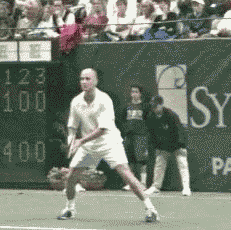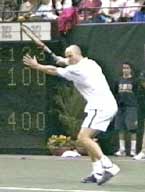<% ns_puts [mkm_getnavbar] %>
Building the Modern Forehand
by John Yandell
Page 3
|
|
Start of the Release
“Elbow in, wrist laid back.” It’s a magic key to the modern forehand. There is no “snap” or release during the hit, and the wrist has nothing to go with generating the power or spin.
The high speed video shows that top players set up in this position at the completion of the backswing, and they keep this position in tact as they move the racquet forward to the hit.
The video also shows they maintain this position until the racquet and racquet hand are well past the contact. Typically, top players maintain the hitting arm for up to two feet outward into the followthrough.
Only after reaching this point does the hitting arm finally start to lose it’s characteristic shape. This is what I call the Start of the Release. At this point the ball has been off the strings for light years in the high speed world of professional tennis.
For players at all levels, this is probably the single most important technical key on the forehand: the image of the palm of the hand driving the racquet from the completion of the backswing out well past the contact.
|
|
The Universal Finish
Another widely debated point about the modern forehand is the finish of the stroke. Is teaching the “wrap” the key to the followthrough? Or is it the consequence of other elements in the swing? We explored this issue in detail in a previous myth article (Myth of the Wrap).
Because the “wrap” appears so distinctive, particularly with the extreme grips, many coaches have adopted it as a central tenet in teaching the modern forehand, training their players to mechanically turn the racquet over at the end of the swing: “Show me the butt of the racquet!”
What the high speed video shows, however, is that most players reach an almost Universal Finish position that precedes the wrap. This position represents the technical completion of the foreswing. It’s our last critical commonality shared across the grip styles. Ironically this position has always been a key component in classical teaching.
The Start of the Release Across the Grip Styles   The start of the release—the last point in the swing with the wrist fully laid back.   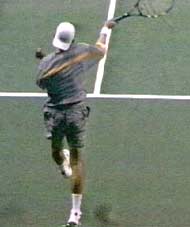 |
The Universal Finish position represents the last point in the swing pattern in which the racquet is traveling either outward or upward, or both. That is, it is the last point in the swing before the racquet starts to move backwards and/or downwards, the so-called “wrap.”
This position has several characteristic checkpoints. Typically the player’s racquet hand will reach about eye level, or a little above or a little below.
|
|
The racquet hand will also be across the body, roughly in line with the left edge of the torso. The forearm will be at an angle of 45 degrees to the court, or sometimes slightly less. The upper arm will be at an angle to the court of about 90 degrees.
Video shows that Sampras, Agassi, Kuerten, Hewitt, Haas, and Safin all reach this position on around 75% of all forehands. This includes most balls in the center of the court, most inside out and inside in balls, most short balls, and even a significant percentage of the balls hit on the run. Even Roddick, who has the most variation in the swing pattern of any player, still gets to this position on close to 50% of his forehands.
Yes, there are variations. In addition to Roddick, you can find examples of the other players with more extreme grips finishing lower, and sometimes much lower, across the body with the racquet ending up at waist level.
What the footage shows, however, is that these are usually variations due to ball position on the court, ball height, ball spin, and the angle of the shot the player is hitting. The universal finish defines a norm that we can use to develop the basic stroke pattern.
The Universal Finish Across the Grip Styles   Across the grip styles on most balls players reach a similar technical finish position: wrist at eye level, forearm at forty five degrees to the court.    |
The checkpoints above represent commonalities across the grip styles. But this is not to say the finishes are completely identical. The biggest difference is the greater amount of internal arm rotation with the extreme grips, something we’ll look at in detail in the next article. This internal arm rotation also accounts for the greater diversity in the swing patterns with extreme grips.
But this finish position includes enough elements common across the grips styles to be considered a true commonality. When we see most top players make the check points for universal finish on 3 out of 4 balls, we can be fairly confident that it really is fundamental. As such it can serve as a model position in developing basic swing patterns as we shall see.
|
|
Extension Outward
A critical further point is the forward extension of the motion at the Universal Finish. So critical that it deserves it’s own extended discussion. We can see this extension in the position of the hand and racquet in relation to the torso. Typically the racquet hand will reach a point that is at least up to two feet in front of the plane of the torso.
This is an indication of the real path of the swing, and how far the racquet has continued outward toward the target before the start of the wrap. This outward extension is present in the forehand of virtually all top players at the Universal Finish. It’s also there even when they fall a little short of the precise finish checkpoints described above.
The importance of the motion from the contact to this
final extension point is widely overlooked and misunderstood by both players
and coaches. It's probably easiest to see from the rear view as the still
photos show.
In addition to the checkpoints outlined above, good extension is a critical
element in the Universal Finish. Unfortunately, the racquet is still moving
so fast at the extension that it is often difficult to see with the naked
eye, even for experienced coaches. And this has caused the importance of the
position to be overlooked, especially with the extreme grips. (See an
example of this below in the story of the teaching pro and Guga's forehand.)
Players mistakenly believe that the wrap is what generates racquet head acceleration. Unfortunately the truth is the exact opposite. By focusing on the wrap, players are limiting their extension and also their racquet head speed. The extension is critical to the path of the racquet and also racquet head speed. Again regardless of grip styles, most top players make this position on most forehands.
Extension and Distance from Torso Across the Grip Styles 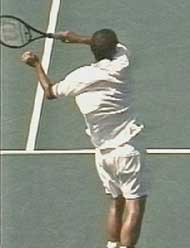  Note how similar the distance is from the racquet hand to torso for these top players across a tremendous range of grip style.   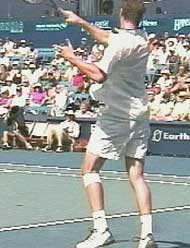 |
The extension precedes the beginning of the wrap. Many players who believe they are imitating the pros miss the extension entirely and get way ahead of themselves in the motion. In an effort to force the wrap, they finish with the hand far too close to the torso. I've filmed even ranked junior players who were hitting themselves in the chest with their racquet hand!
In fact, the wrap is actually an after effect caused by good extension. Ironically, by trying so hard to "wrap" they are creating the opposite effect they intend.
A 3-dimensional study of top college players completed by Advanced Tennis showed that racquet head speed during the wrap declines radically, down to about 5mph or less. This is a fraction of the speed at the contact, and still far less than the racquet head speed at the Universal Finish. (More on this study coming in future articles.)
|
|
If you think about this, it makes perfect sense. The wrap is the natural “deceleration” phase of the forehand motion. What speeds up has to slow down. Teaching the wrap to generate racquet head speed violates a basic principle of bio-mechanics, and probably, increases the chance of injury.
High speed video shows that pro players pass through the technical finish position, with great extension away from the torso. Only then do they decelerate the racquet by moving it backward toward the body, the “wrap” phase of the stroke.
You'll see the racquet moves further as it accelerates
to contact and through the extension of the motion, and much less as it
starts to move backwards through the wrap.
You can actually measure this for yourself by studying the movie of Guga's forehand
above, and clicking through the motion frame by frame in the
high speed video.
Click the first 20 frames. This will take you from the contact point to the
universal finish. The actual time duration is a little less than 2/10s of a
second. Notice how far the racquet has moved through the line of the shot,
out toward the target and then up to the finish.
Now click the next 20 frames. That will take you from the universal finish
to the end of the wrap. Compare the distance the racquet travels! You can
see with the naked eye it's obviously much less. It's the same amount of
clicks and the same time interval, but the racquet moves probably something
like half as far. There's no doubt the racquet slows down dramatically.
|
|
Let’s be clear: the wrap is a critical part of the motion on the modern forehand. But let’s not confuse acceleration and deceleration. Most players will naturally wrap as a consequence of extending their swing. They have to--in order to slow down the racquet smoothly and keep from putting additional strain on their shoulder muscles.
Unfortunately what we see in great numbers of junior players who have been taught to wrap is that they never make the technical finish position that great players with the same grip styles achieve. This is the way so many of them hit forehands that are heavily spun, but lack velocity or depth.
Because the racquet is moving so much slower during the wrap, it is much easier to see the wrap than the extension of the swing, and this has added to the coaching confusion. Because they can see it more clearly, coaches often seize on the wrap in order to have some way to understand the extreme forehands.
What they don’t see is the universal finish because it happens so much faster. Even watching Advanced Tennis video, you can sometimes miss or overlook this position if you don’t stop and go frame by frame.
At a recent coaching convention where I was speaking, a teaching pro who was a big Kuerten fan, was checking out the high speed video.
After seeing Guga finish a few forehands with the wrap across the body, he started modeling Guga’s stroke and telling me how this was exactly how he had taught all his juniors to hit heavy topspin. I noticed, however, that his racquet hand wasn’t even reaching shoulder level before crossing over his body, so I asked him to take a look at the Guga footage frame by frame.
When he saw Guga reach the universal finish position on several balls, he decided that Guga really didn’t hit his forehand that well after all, maybe not even as well as his own 12 year old son. Then he proceeded to tell me how he thought Guga should take some lessons from him and learn to shorten his followthrough.
|
|
Now that was a strong response (strongly defensive!), and I had to laugh, but it provides another example of how even experienced teachers can be fooled when looking at tennis strokes and how these misperceptions can harden into principles teachers will naturally want to defend.
Teachers think that by stressing the wrap, they are teaching what is new in the modern forehand. But, as we saw in the Myth of the Wrap article, the wrap is absolutely nothing new. Big Bill Tilden had a full wrapping motion on his classic eastern forehand, and so did Pancho Gonzales and Jack Kramer. And so does Pete Sampras.
What is new is the way the wrap appears to be more extreme with the western grips. The increased internal arm rotation in the swing makes the wrap look more dramatic, particularly on the lower finishes across the body, and that has caught the attention of coaches and players.
If the player reaches the universal finish the wrap usually just happens. In fact, it would be difficult to stop it from happening.
But should coaches be stressing the wrap? In my experience this inevitably leads to restrictions in the extension. The only exception would be in the case of a player with an extremely rigid swing, and the point would still be to relax and let the racquet wrap on its own, rather than forcing it to happen.
Summary of the Key Positions of the Modern
Forehand
|
| Ready | Start of Turn | Full Turn | Start of Foreswing |



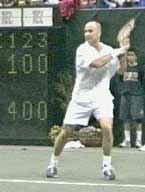
| Contact | Start of Release | Universal Finish | Wrap |
So let's review. As the still sequence and the animation of Agassi shows, across the grips on the modern forehand, we see multiple commonalties in the swing pattern: the two part turning motion, the completion of the backswing and the set up of hitting arm position as the forward swing starts, the contact with the elbow in and wrist back, the continuation of this hitting arm position well after contact until the start of the release, the universal finish, and finally the wrap.
Yes there are commonalities. But there are real and important differences as well. In the next two articles we look at those in detail, starting with the backswings. Then it'll be on to the stances and recovery steps, and finally, creating the physical and mental models. Stay tuned!
|
Want to study high speed video of
the modern forehand for yourself (as well as all the other
strokes)? |
Your comments are welcome. Let us know what you think about John Yandell's article by emailing us here at TennisONE.
To contact us, please email to: webmaster@tennisone.com
TennisONE is a registered trademark of TennisONE and SportsWeb ONE; Copyright 1995. All rights reserved.









